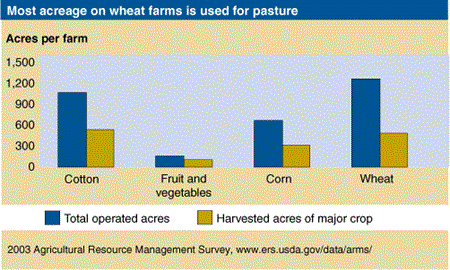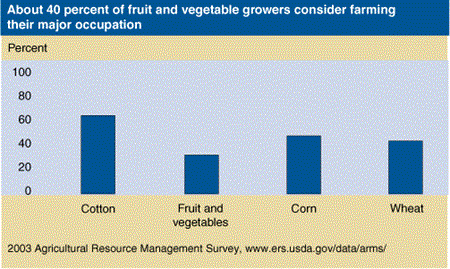Data Feature
ARMS Data Allow Comparisons Across Diverse Farm Types
USDA’s annual Agricultural Resource Management Survey (ARMS) is the primary source of information on the financial condition, production practices, resource use, and economic well-being of America’s farm households. Using these data, ERS researchers analyzed the economic performance of specialized farms—defined as farms that receive 50 percent or more of their gross value of production from the sale of a specific commodity. A comparison of these farm types highlights the differences among specific commodity farms and the households that operate them with respect to household income, Government payments, and demographic characteristics of farm operators.
Farms specializing in corn, fruit and vegetables, wheat, and cotton are concentrated in different regions across the United States, reflecting the best locations for growing each of these commodities. Corn is grown mostly in the Midwest, wheat in the Northern Plains and Southern Plains, fruit and vegetables near the coasts, and cotton in the Southern and Western States. Some of the differences among farm types reflect variations in regions.
Wheat and Cotton Farms Are the Largest
Wheat farms and cotton farms, on average, are the largest farms, both in terms of total operated acres and acres devoted to their major commodity. Wheat farms are large because most of the operated acres are used for pasture or left fallow. Cotton is very capital intensive, requiring large expenditures for equipment; farmers prefer to spread these costs over more acres. On average, fruit and vegetable farms tend to be the smallest in area, compared with the other three types of farms—many fruit and vegetable farms are located close to metropolitan areas, where land is more expensive and competition for land between agricultural and urban users is more intense. Fruit and vegetable farms that are highly specialized and intensively farmed are best suited for these regions.
These large wheat and cotton farms are also less specialized than fruit and vegetable farms and corn farms. Less than 50 percent of the land on wheat and cotton farms is planted to these crops. Land not planted to wheat is often left fallow in dry areas, such as in the Northern Plains, and is also used as pasture for cattle grazing. Cotton growers rotate in and out of cotton, planting soybeans, corn, or sorghum on land not planted to cotton. In contrast, fruit and vegetable farms are the most specialized because they are small, high value, and labor intensive, and located in areas not suited for row crops.
Cotton Farms Receive the Highest Government Payments
These four types of farms also differ significantly by source of income. Three main sources of income are farm sales, Government payments, and off-farm income. Farm households of all types typically have significant sources of off-farm income—these include off-farm jobs, ownership of nonfarm businesses or nonfarm investments, Social Security benefits, and other retirement income.
According to ARMS data on sources of income by farm type, households operating cotton farms brought in the highest total income, onfarm income, and Government payments. Households operating fruit and vegetable farms were second after cotton farms in terms of total income. However, while their total income was higher than that of households operating corn and wheat farms, more of that income came from off-farm sources. Because there are no program payments for fruit and vegetables, Government payments were lowest on these farms.
Not All Farmers Consider Farming Their Major Occupation
In an attempt to determine how farm operators allocate their time, ERS used ARMS data to classify farmers by their major occupation: farm or ranch work, hired farm manager, retired but still farming, or nonfarm work. For all farms, operators were just as likely to identify nonfarm work as their major occupation as they were farming or ranching. Some operators indicated that they were not in the workforce, and most of these considered themselves to be retired. Consistent with the average size of their farms, the share of operators whose major occupation is farming was lowest on fruit and vegetable farms and highest on cotton farms. However, even among farmers who primarily raised corn and wheat, about 50 percent said their occupation was something other than farming.
ERS Outlook Reports and Data, by Jennifer K. Bond, USDA, Economic Research Service, June 2022
ARMS Farm Financial and Crop Production Practices, by ARMS Team, USDA, Economic Research Service, December 2023





